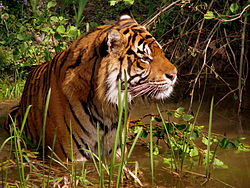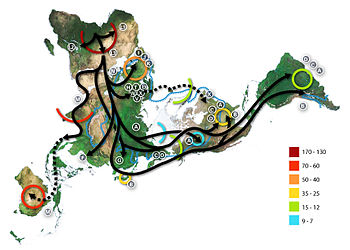
Wildlife
Background Information
The articles in this Schools selection have been arranged by curriculum topic thanks to SOS Children volunteers. Child sponsorship helps children one by one http://www.sponsor-a-child.org.uk/.
Wildlife traditionally refers to non- domesticated vertebrates, but has come to broadly reference to all wild plants, animals and other organisms . Domesticating wild plant and animal species for human benefit has occurred many times all over the planet, and has a major impact on the environment, both positive and negative.
Wildlife can be found in all ecosystems. Deserts, forests, rain forests, plains, grasslands, other areas including the most developed urban sites, all have distinct forms of wildlife. While the term in popular culture usually refers to animals that are untouched by human factors, most scientists agree that wildlife around is affected by human activities.
Humans have historically tended to separate civilization from wildlife in a number of ways including the legal, social, and moral sense. Religions have often declared certain animals to be sacred, and in modern times concern for the natural environment has provoked activists to protest the exploitation of wildlife for human benefit or entertainment.
Food, pets, and traditional medicines
Anthropologists believe that the Stone Age people and hunter-gatherers relied on wildlife, both plants and animals, for their food. In fact, some species may have been hunted to extinction by early human hunters. Today, hunting, fishing, and gathering wildlife is still a significant food source in some parts of the world. In other areas, hunting and non-commercial fishing are mainly seen as a sport or recreation, with the edible meat as mostly a side benefit. Meat sourced from wildlife that is not traditionally regarded as game is known as bush meat. The increasing demand for wildlife as a source of traditional food in East Asia is decimating populations of sharks, primates, pangolins and other animals, which they believe have aphrodisiac properties.
In November 2008, almost 900 plucked and "oven-ready" owls and other protected wildlife species were confiscated by the Department of Wildlife and National Parks in Malaysia, according to TRAFFIC. The animals were believed to be bound for China, to be sold in wild meat restaurants. Most are listed in CITES (the Convention on International Trade in Endangered Species of Wild Fauna and Flora) which prohibits or restricts such trade.
| “ | Malaysia is home to a vast array of amazing wildlife. However, illegal hunting and trade poses a threat to Malaysia’s natural diversity. | ” |
|
—Chris S. Shepherd |
||
A November 2008 report from biologist and author Sally Kneidel, PhD, documented numerous wildlife species for sale in informal markets along the Amazon River, including wild-caught marmosets sold for as little as $1.60 (5 Peruvian soles). Many Amazon species, including peccaries, agoutis, turtles, turtle eggs, anacondas, armadillos, etc., are sold primarily as food. Others in these informal markets, such as monkeys and parrots, are destined for the pet trade, often smuggled into the United States. Still other Amazon species are popular ingredients in traditional medicines sold in local markets. The medicinal value of animal parts is based largely on superstition.
Religion
Many animal species have spiritual significance in different cultures around the world, and they and their products may be used as sacred objects in religious rituals. For example, eagles, hawks and their feathers have great cultural and spiritual value to Native Americans as religious objects.
Tourism
Many countries have established their tourism sector around their natural wildlife. South Africa has, for example, many opportunities for tourists to see the country's wildlife in its National Parks, such as the Kruger Park.
Destruction
This subsection focuses on anthropogenic forms of wildlife destruction.
Exploitation of wild populations has been a characteristic of modern man since our exodus from Africa 130,000 – 70,000 years ago. The rate of extinctions of entire species of plants and animals across the planet has been so high in the last few hundred years it is widely believed that we are in the sixth great extinction event on this planet; the Holocene Mass Extinction.
Destruction of wildlife does not always lead to an extinction of the species in question, however, the dramatic loss of entire species across Earth dominates any review of wildlife destruction as extinction is the level of damage to a wild population from which there is no return.
The four most general reasons that lead to destruction of wildlife include overkill, habitat destruction and fragmentation, impact of introduced species and chains of extinction.
Overkill
Overkill happens whenever hunting occurs at rates greater than the reproductive capacity of the population is being exploited. The effects of this are often noticed much more dramatically in slow growing populations such as many larger species of fish. Initially when a portion of a wild population is hunted, an increased availability of resources (food, etc.) is experienced increasing growth and reproduction as density dependent inhibition is lowered. Hunting, fishing and so on, has lowered the competition between members of a population. However, if this hunting continues at rate greater than the rate at which new members of the population can reach breeding age and produce more young, the population will begin to decrease in numbers.
Populations that are confined to islands, whether literal islands or just areas of habitat that are effectively an “island” for the species concerned, have also been observed to be at greater risk of dramatic population declines following unsustainable hunting.
Habitat destruction and fragmentation

The habitat of any given species is considered its preferred area or territory. Many processes associated human habitation of an area cause loss of this area and decrease the carrying capacity of the land for that species. In many cases these changes in land use cause a patchy break-up of the wild landscape. Agricultural land frequently displays this type of extremely fragmented, or relictual, habitat. Farms sprawl across the landscape with patches of uncleared woodland or forest dotted in-between occasional paddocks.
Examples of habitat destruction include grazing of bushland by farmed animals, changes to natural fire regimes, forest clearing for timber production and wetland draining for city expansion.
Impact of introduced species
Mice, cats, rabbits, dandelions and poison ivy are all examples of species that have become invasive threats to wild species in various parts of the world. Frequently species that are uncommon in their home range become out-of-control invasions in distant but similar climates. The reasons for this have not always been clear and Charles Darwin felt it was unlikely that exotic species would ever be able to grow abundantly in a place in which they had not evolved. The reality is that the vast majority of species exposed to a new habitat do not reproduce successfully. Occasionally, however, some populations do take hold and after a period of acclimation can increase in numbers significantly, having destructive effects on many elements of the native environment of which they have become part.
Chains of extinction
This final group is one of secondary effects. All wild populations of living things have many complex intertwining links with other living things around them. Large herbivorous animals such as the hippopotamus have populations of insectivorous birds that feed off the many parasitic insects that grow on the hippo. Should the hippo die out, so too will these groups of birds, leading to further destruction as other species dependent on the birds are affected. Also referred to as a domino effect, this series of chain reactions is by far the most destructive process that can occur in any ecological community.
Another example is the black drongos and the cattle egrets found in India. These birds feed on insects on the back of cattle, which helps to keep them disease-free. Destroying the nesting habitats of these birds would cause a decrease in the cattle population because of the spread of insect-borne diseases.


